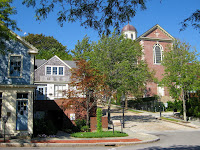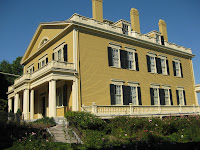 After breakfast, buses were waiting to take excursion passengers to the New Bedford Whaling Museum (far left), the major attraction in town. The Museum lies within the New Bedford Whaling National Historical Park that covers 13 blocks of the historical district, encompassing cobbled streets and restored mid-19th century buildings.
After breakfast, buses were waiting to take excursion passengers to the New Bedford Whaling Museum (far left), the major attraction in town. The Museum lies within the New Bedford Whaling National Historical Park that covers 13 blocks of the historical district, encompassing cobbled streets and restored mid-19th century buildings.The layout and scale of the Museum were truly impressive as can be seen by the accompanying photos.
 KOBO (King of the Blue Ocean), the centerpiece of the New Bedford Whaling Museum's entrance gallery. This is the skeleton of a 66-foot-long Blue whale that was accidentally struck and killed by a tanker off Nova Scotia. It is only one of three such skeletons on display in the world. For more information, click KOBO, and try moving your browser over the interactive images.
KOBO (King of the Blue Ocean), the centerpiece of the New Bedford Whaling Museum's entrance gallery. This is the skeleton of a 66-foot-long Blue whale that was accidentally struck and killed by a tanker off Nova Scotia. It is only one of three such skeletons on display in the world. For more information, click KOBO, and try moving your browser over the interactive images. The Lagoda, the Museum's 89-foot half-scale model of a fully rigged whaling bark. This is a "hands on" exhibit, and visitors are free to climb aboard, to take a closer look. For more information, click The Lagoda, and try moving your browser over the interactive images.
The Lagoda, the Museum's 89-foot half-scale model of a fully rigged whaling bark. This is a "hands on" exhibit, and visitors are free to climb aboard, to take a closer look. For more information, click The Lagoda, and try moving your browser over the interactive images. Part of the excellent scrimshaw exhibit at the Museum.
Part of the excellent scrimshaw exhibit at the Museum. The Seamen’s Bethel, circa 1831, is located on Johnny Cake Hill, across the street from the New Bedford Whaling Museum. Herman Melville's classic novel, Moby Dick, immortalized "Whaleman's Chapel" as a refuge for sailors from the rigors and stresses of maritime life.
The Seamen’s Bethel, circa 1831, is located on Johnny Cake Hill, across the street from the New Bedford Whaling Museum. Herman Melville's classic novel, Moby Dick, immortalized "Whaleman's Chapel" as a refuge for sailors from the rigors and stresses of maritime life.Our walking route took us up Williams Street, the principal commercial artery of New Bedford. About 8 blocks north, we reached County Street, lined with the most magnificent examples of Victorian residential architecture in New Bedford.
 The Marcia Parker House, 413 County Street is a Queen Anne constructed between 1889 and 1892 for Marcia Parker, the widow of Ward Parker, a whaling captain.
The Marcia Parker House, 413 County Street is a Queen Anne constructed between 1889 and 1892 for Marcia Parker, the widow of Ward Parker, a whaling captain. The Gilbert Russell/Dr. Edward Abbe House, 405 County Street, was originally a Federal style mansion dating to 1805. Dr. Abbe remodeled the house in a flamboyant Italianate Victorian style with French and oriental elements between 1860 and 1897. (Notes courtesy of New Bedford Preservation Society).
The Gilbert Russell/Dr. Edward Abbe House, 405 County Street, was originally a Federal style mansion dating to 1805. Dr. Abbe remodeled the house in a flamboyant Italianate Victorian style with French and oriental elements between 1860 and 1897. (Notes courtesy of New Bedford Preservation Society).After spending the late morning looking at these beautifully preserved Victorians, we meandered through the downtown historical district back to the ship for lunch.
 We are looking up Johnny Cake Hill, with the 1966 New Bedford Whaling Museum on the right. Its architecture fits right in with the Victorian residences and shops on the left.
We are looking up Johnny Cake Hill, with the 1966 New Bedford Whaling Museum on the right. Its architecture fits right in with the Victorian residences and shops on the left. The American Spirit offered an afternoon harbor excursion to Fairhaven, and a close-up view of the New Bedford Harbor Hurricane Barrier (above). (After clicking the link, explore the interactive photo-map by placing your browser over the boxes). Note: Should we receive e-mails and photos about the harbor cruise, we will add the information to this blog.
The American Spirit offered an afternoon harbor excursion to Fairhaven, and a close-up view of the New Bedford Harbor Hurricane Barrier (above). (After clicking the link, explore the interactive photo-map by placing your browser over the boxes). Note: Should we receive e-mails and photos about the harbor cruise, we will add the information to this blog. We opted to spend the afternoon walking back to County Street and visiting the Rotch-Jones-Duff House and Garden Museum. This mild, sunny day was ideal for a house and garden tour.
We opted to spend the afternoon walking back to County Street and visiting the Rotch-Jones-Duff House and Garden Museum. This mild, sunny day was ideal for a house and garden tour. We then walked past some shops, such as this nautical antique store, and explored some of the historic waterfront before returning to the ship.
We then walked past some shops, such as this nautical antique store, and explored some of the historic waterfront before returning to the ship. Here is a typical view of the fishing fleet in New Bedford Harbor.
Here is a typical view of the fishing fleet in New Bedford Harbor.
As we headed for the gangplank, we were greeted by a religious procession, presented by the local Portuguese community. New Bedford has an active Portuguese/Madeira presence; visit http://www.portuguesefeast.com/, for information on the Feast of the Blessed Sacrament, held in late summer every year.
We left in late afternoon for Nantucket. We cruised through the Harbor Hurricane Barrier on our way to Buzzard's Bay and Nantucket Sound. As we headed for our off-shore anchoring in Nantucket harbor, Sandy Balla's evening talk covered the excursion options and sights to look forward to tomorrow.
No comments:
Post a Comment